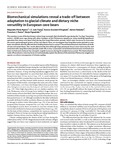Biomechanical simulations reveal a trade-off between adaptation to glacial climate and dietary niche versatility in European cave bears

Use this link to cite
http://hdl.handle.net/2183/25598Collections
- Investigación (FCIE) [1150]
Metadata
Show full item recordTitle
Biomechanical simulations reveal a trade-off between adaptation to glacial climate and dietary niche versatility in European cave bearsAuthor(s)
Date
2020-04-01Citation
A. Pérez-Ramos, Z. J. Tseng, A. Grandal-D’Anglade, G. Rabeder, F. J. Pastor, B. Figueirido, Biomechanical simulations reveal a trade-off between adaptation to glacial climate and dietary niche versatility in European cave bears. Sci. Adv. 6, eaay9462 (2020).
Abstract
[Abstract] The cave bear is one of the best known extinct large mammals that inhabited Europe during the “Ice Age,” becoming extinct ≈24,000 years ago along with other members of the Pleistocene megafauna. Long-standing hypotheses speculate that many cave bears died during their long hibernation periods, which were necessary to overcome the severe and prolonged winters of the Last Glacial. Here, we investigate how long hibernation periods in cave bears would have directly affected their feeding biomechanics using CT-based biomechanical simulations of skulls of cave and extant bears. Our results demonstrate that although large paranasal sinuses were necessary for, and consistent with, long hibernation periods, trade-offs in sinus-associated cranial biomechanical traits restricted cave bears to feed exclusively on low energetic vegetal resources during the predormancy period. This biomechanical trade-off constitutes a new key factor to mechanistically explain the demise of this dominant Pleistocene megafaunal species as a direct consequence of climate cooling.
Keywords
Ursus spelaeus
Biomechanics
Paranasal sinuses
Hibernation
Biomechanics
Paranasal sinuses
Hibernation
Editor version
Rights
Atribución-NoComercial 4.0 España
ISSN
2375-2548






